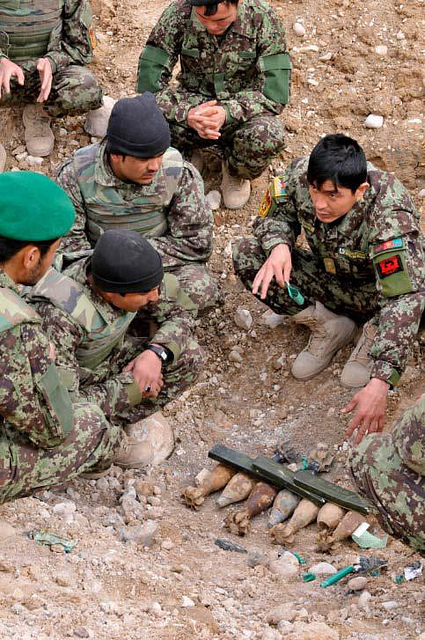WASHINGTON — Now is time for insurgents in Afghanistan to lay their weapons down and rejoin their communities, a top NATO military official said today.
Speaking to Pentagon reporters here via videoconference from his headquarters in Kabul, Afghanistan, British army Maj. Gen. Phil Jones credited recent security gains throughout the country for setting the stage for a growing reintegration program.
“Security gains have two effects. It gives the community a confidence to support [reintegration]. It also creates an environment for groups to come back and reintegrate,” said Jones, who heads the International Security Assistance Force’s force integration cell.
The Afghan program provides support to insurgents and groups who want to formally reintegrate into their communities. The program started in July 2010, shortly after the surge of 30,000 U.S. troops began arriving in Afghanistan to beef up security.
“The peace process supports fighters and their communities to rejoin Afghanistan with honor and dignity, providing they renounce violence, sever ties with terrorist groups and live under the constitution,” Jones said. “As we start to see the security gains made over the autumn period solidified, people get a sense that they are irreversible.”
Jones pointed to recent reintegration progress in northwestern Badghis province as an example of the type of successes they have seen. The security situation there has completely turned around for the good, he said.
He described Badghis as a poor province with vast health and education deficiencies that contributed greatly to a growing insurgency there. The government had little control or influence. But after stepping up security operations and removing some key insurgents, the government was afforded a new platform for change, he said.
“On the back of those security gains and on the back of some really excellent political outreach, we now have something like 400 armed men who have reintegrated over the past four months,” Jones said. “And, frankly, the security situation in Badghis has changed out of all recognition.”
Jones said that coalition forces and Badghis government leaders recently sat down with about 40 ex-insurgents and discussed ways forward for peace. Also, he noted similar meetings in Laghman province with about 83 recently reintegrated Taliban fighters.
Of the 25,000 insurgents ISAF estimates bear arms against NATO forces and the Afghan government, about 1,740 have formally reintegrated back into society, Jones said. Although that is only a small percentage, a much larger progress is looming, he said.
“Problems still remain – absolutely no doubt, but there’ve been some really big steps forward,” he said. “This is, at its heart, all about fighters leaving the fight and beginning to build community cohesion and stability from the grass roots up.”
Reintegration meetings are now occurring in 15 provinces, and are likely to start in at least five others, he said. The recent killing of al-Qaida leader Osama bin Laden also has had some effect, he noted, adding that a several low-level insurgent groups have since shown interest in the program.
In addition, Jones expects that as many as 2,000 fighters will bypass the formal reintegration process and simply lay down their weapons and return home.
Still, some elders and armed fighters are hesitant to participate.
“As any of the elders will tell you, after 20 years of war and 10 years of insurgency, Afghans will be cautious about committing with their futures,” the general said. “These are life-changing decisions that people are making, and it is all built on trust and confidence and will only move at the speed of trust and confidence.”
Jones stressed the importance of remaining optimistic and having patience with the reintegration efforts.
“The deficit of trust and the lack of confidence after 30 years of fighting here in Afghanistan is quite profound,” Jones said. “The decisions people are making are not taken lightly, nor are they taken necessarily quickly. Their lives depend upon the decisions they make.
“We’ve got to be careful not to be unrealistically optimistic, but we in ISAF are seeing a lot of potential for this process to expand and accelerate as it begins to have impact on many communities across Afghanistan,” he said.
Source:
U.S. Department of Defense
Office of the Assistant Secretary of Defense (Public Affairs)

 von
von 